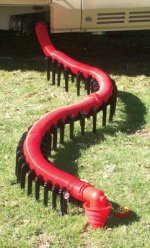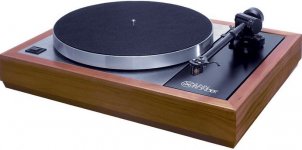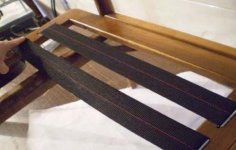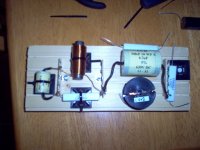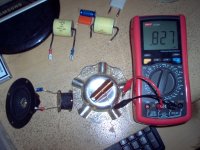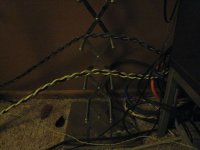No, there was ample subjective reviews of TTs, tonearms, plinths...........also ample technical discussion for that matter - they mostly had it well sorted before the plot got lost somehow, if one rereads old articles and papers.My memory is of reviews discussing measurements and build quality, not subjective valuations of their sound. But then I only read Hi Fi News in those days, which was pretty staid.
To quote Ken Kessler:
"As most other audio magazines, HFN&RR had its better and worse times. Often the good was related to the bad, which makes it difficult to judge overall. This was the case with, for example, the 1960s period when the reviews were based on a technical overview and measurements. According to this approach, most amplifiers sounded the same, regardless of how they did in reality. To counter this approach, magazines such as Stereophile and The Absolute Sound surfaced, so we can say that this “wrong path” was useful in a way."
"As most other audio magazines, HFN&RR had its better and worse times. Often the good was related to the bad, which makes it difficult to judge overall. This was the case with, for example, the 1960s period when the reviews were based on a technical overview and measurements. According to this approach, most amplifiers sounded the same, regardless of how they did in reality. To counter this approach, magazines such as Stereophile and The Absolute Sound surfaced, so we can say that this “wrong path” was useful in a way."
Perhaps I should just have said that although I think lifting cables is nonsense, ridiculing it from the position of not trying it, would say more about me than the viability of the idea.
There are ideas that are so stupid on the face of it that anyone wasting time on them (in the absence of reliable data to the contrary from people making claims- which happens approximately 0% of the time) is three fries short of a Happy Meal. Hobby and fashion audio is rife with these.
There is a certain amount of science involved in cables. We might discuss this now. 🙂
But first, let's discuss those old microphonic turntables. Because the LP cartridge was a microphone to vibrations in the LP groove. It was always well known that to put a turntable near a speaker or near thumping footsteps was a BAD THING! 😀
The Linn Sondek had good acoustic isolation, being mounted on soft springs. It was quite forgiving. Hence sounded good. Sofa webbing works well too.
I decided the simpler solution was to put the turntable and amplification in another next-door quiet room on a solid plinth. Gave much better bass and resolution! 🙂
This business with lifting cables might have a much simpler solution. Whatever effects are created by having a dielectric, or metal plane, or mains hum near the floorboards, they will be reduced by twisting the cables:
Twisted pair - Wikipedia, the free encyclopedia
In practise, cables (maybe 100-150 ohms characteristic impedance) are higher impedance than 8 ohm speakers, so the effects at the speaker termination are inductive. So run those cables on the floor, but TWIST them if the effect of a nearby dielectric or ground plane or mains hum is significant. That's what the science says. 😎
There are measurable effects from nearby metal surfaces on coils. Hence I have abandoned metal PCBs in favour of wooden crossover mounts. This 1mH coil measures about 20% different near a metal ground plane. I take it you all understand right-angled placement of coils to reduce interaction.
But first, let's discuss those old microphonic turntables. Because the LP cartridge was a microphone to vibrations in the LP groove. It was always well known that to put a turntable near a speaker or near thumping footsteps was a BAD THING! 😀
The Linn Sondek had good acoustic isolation, being mounted on soft springs. It was quite forgiving. Hence sounded good. Sofa webbing works well too.
I decided the simpler solution was to put the turntable and amplification in another next-door quiet room on a solid plinth. Gave much better bass and resolution! 🙂
This business with lifting cables might have a much simpler solution. Whatever effects are created by having a dielectric, or metal plane, or mains hum near the floorboards, they will be reduced by twisting the cables:
Twisted pair - Wikipedia, the free encyclopedia
In practise, cables (maybe 100-150 ohms characteristic impedance) are higher impedance than 8 ohm speakers, so the effects at the speaker termination are inductive. So run those cables on the floor, but TWIST them if the effect of a nearby dielectric or ground plane or mains hum is significant. That's what the science says. 😎
There are measurable effects from nearby metal surfaces on coils. Hence I have abandoned metal PCBs in favour of wooden crossover mounts. This 1mH coil measures about 20% different near a metal ground plane. I take it you all understand right-angled placement of coils to reduce interaction.
Attachments
There is a certain amount of science involved in cables. We might discuss this now. 🙂
This business with lifting cables might have a much simpler solution. Whatever effects are created by having a dielectric, or metal plane, or mains hum near the floorboards, they will be reduced by twisting the cables:
Twisted pair - Wikipedia, the free encyclopedia
In practise, cables (maybe 100-150 ohms characteristic impedance) are higher impedance than 8 ohm speakers, so the effects at the speaker termination are inductive. So run those cables on the floor, but TWIST them if the effect of a nearby dielectric or ground plane or mains hum is significant. That's what the science says. 😎
This is what Rod Elliott has to say about speaker cable Zo on his site:
"Note that Zo is a constant, and is independent of the length of the cable. An ideal cable (for a high powered audio system) will have low inductance, low capacitance and low DC resistance (DCR), but it is important to understand that the Zo of the cable is completely unimportant at audio frequencies."
He also points out that characteristic impedance (Zo) only comes into play if everything is impedance matched which in case of the amp-speaker interface is practically impossible as both the amps output impedance and the speakers input impedance vary with frequency.
In my own case I have this situation: Amp output impedance 0.02Ohm, cable resistance <0.04Ohm and speaker impedance is >5.6Ohm. No idea about the cables Zo. The manufacturer gives fairly comprehensive info but that isn't one of them.
Do I need to twist or lift? ;-)
Twist or Lift? I don't know! 😀
This might not be snake-oil though.
Most cable effects come into play on extremely long runs of cable in power and telecoms applications.
Characteristic impedance - Wikipedia, the free encyclopedia
Noise suppression and efficiency are the considerations.
Per meter, the effects are of the order of a 100pF and fractions of a uH. There are some complications with self and mutual inductance too, because characteristic impedance is a radio frequency effect affected by skin effect in conductors. It kicks in around 100kHz.
But we really don't do things properly in audio, for sure. Amps are usually unbalanced output, which means live and earth. We should be using coaxial 8 ohm speaker cables to get that right. And impedance correcting the speakers to a flat resistance.
The twinned pair speaker cables we buy are technically better suited to balanced line, which is positive and negative output with a centre earth. In fact, you can wire some power amplifiers into bridged mode to get near this. Pro-Audio does this with long runs of 300 ohm shielded pair cable at microphone level. And terminated by 300 ohm too. Then it all works correctly. It avoids mains hum and radio pickup and noise from nearby switching.
This might not be snake-oil though.
Most cable effects come into play on extremely long runs of cable in power and telecoms applications.
Characteristic impedance - Wikipedia, the free encyclopedia
Noise suppression and efficiency are the considerations.
Per meter, the effects are of the order of a 100pF and fractions of a uH. There are some complications with self and mutual inductance too, because characteristic impedance is a radio frequency effect affected by skin effect in conductors. It kicks in around 100kHz.
But we really don't do things properly in audio, for sure. Amps are usually unbalanced output, which means live and earth. We should be using coaxial 8 ohm speaker cables to get that right. And impedance correcting the speakers to a flat resistance.
The twinned pair speaker cables we buy are technically better suited to balanced line, which is positive and negative output with a centre earth. In fact, you can wire some power amplifiers into bridged mode to get near this. Pro-Audio does this with long runs of 300 ohm shielded pair cable at microphone level. And terminated by 300 ohm too. Then it all works correctly. It avoids mains hum and radio pickup and noise from nearby switching.
Last edited:
Maple will give you a sweeter sound. Ash will be firmer and more solid. If you want to lighten the sound a bit, try balsa.
*snicker
This might not be snake-oil though.
Yes, it is. I think you're having some issues with understanding signal flow, but that's not uncommon in hobby audio. "Characteristic impedance" is absolutely irrelevant here. So are your other speculations.
If you want to actually understand what's going on, the subject was covered exhaustively about 35 years ago by Dick Greiner and Fred Davis.
I'm not really having an opinion about this. I just buy the regular cables and use them in the regular way. 🙂Yes, it is. I think you're having some issues with understanding signal flow, but that's not uncommon in hobby audio. "Characteristic impedance" is absolutely irrelevant here. So are your other speculations.
If you want to actually understand what's going on, the subject was covered exhaustively about 35 years ago by Dick Greiner and Fred Davis.
But there are some weirdnesses in Audio. Mains Power gets better at night when people switch off their PCs. This is apparently because SMPS power supplies dump a DC offset onto the mains. So your amp works better. Maybe.
And I once went to a party near the Crystal Palace radio transmitter. The record player was playing Radio 2 in the background. So who's to say these cables might not be affected by radio broadcasts, or mains hum, for instance? 😕
I think I'll side with Rod Elliott and SY on this one.
Zo is irrelevant for speaker cables.
In the years I worked alongside one of the UKs major PA hire companies I've never come across anybody specifically terminating mic level cables when they were making multicores. Neither did we but we were a lighting company.
I suppose they do now but now everything is digitally connected.
Zo is irrelevant for speaker cables.
In the years I worked alongside one of the UKs major PA hire companies I've never come across anybody specifically terminating mic level cables when they were making multicores. Neither did we but we were a lighting company.
I suppose they do now but now everything is digitally connected.
Lift audio cables
May I suggest to keep a tray (99.99 silver?) below the lifted cables to collect the dripping audio waves. What to do when the tray overflows? Can anyone suggest some solution please?
Regards,
mandu.
May I suggest to keep a tray (99.99 silver?) below the lifted cables to collect the dripping audio waves. What to do when the tray overflows? Can anyone suggest some solution please?
Regards,
mandu.
So who's to say these cables might not be affected by radio broadcasts, or mains hum, for instance? 😕
The cables, no. The amps, yes. Lifters? Amazingly stupid idea, except for the ripoff artists selling them.
Radio signals finding it's way back to the amp is a well known problem. Strong MW and SW for those living close enough. CB radio was a real PITA. This has nothing to do with cables as such - except a possible cure is no cables...... 🙂 Other cures might be tricky.....
Everybody enjoying this, I can tell...😀
Characteristic Impedance is just a property of cables. It was certainly something you considered with microphones and moving magnet cartridges into 47k loads.
The 150pF of cable capacitance from a typical meter of badly terminated 100 ohm coaxial cable had a huge effect on the top end frequency response.
How relevant to speaker cables? Hard to see a mechanism here. But it would do no harm at all to shunt the tweeter, and hence the cable, with 100 ohms, if it isn't already in GFK's crossover. That makes it behave better at radio frequency. It's still a bit of an aerial in common mode though.
Common mode and differential mode all gets quite difficult. But it's a definite distortion mechanism in amplifiers. So while we laugh at the monkeys in the Zoo, we should remember that they are probably laughing at us. 🙂
Characteristic Impedance is just a property of cables. It was certainly something you considered with microphones and moving magnet cartridges into 47k loads.
The 150pF of cable capacitance from a typical meter of badly terminated 100 ohm coaxial cable had a huge effect on the top end frequency response.
How relevant to speaker cables? Hard to see a mechanism here. But it would do no harm at all to shunt the tweeter, and hence the cable, with 100 ohms, if it isn't already in GFK's crossover. That makes it behave better at radio frequency. It's still a bit of an aerial in common mode though.
Common mode and differential mode all gets quite difficult. But it's a definite distortion mechanism in amplifiers. So while we laugh at the monkeys in the Zoo, we should remember that they are probably laughing at us. 🙂
Usually, a couple of ten cent ceramic discs will get rid of RFI coming in from the amp's output side.
How relevant to speaker cables?
Not at all.
Twenty cents will buy a nice spread down there in Texas.SY, you're bankrupting me!!!
- Status
- Not open for further replies.
- Home
- Member Areas
- The Lounge
- Speaker Cable lifters or stands?
